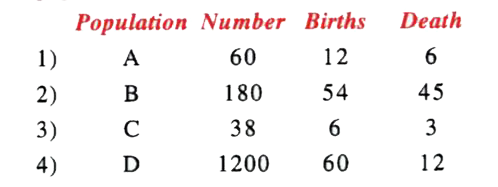Consider a hypothetical case of a radinuclide A which produces a daughter B which is turn decays to a stable product C. the half life of B is 5 times that of A. take initial population of both B and C to be zero.
(a) Using qualitative arguments only, plot the variation of population of A,B and C with time.
(b) Find the ratio of population of B to that of A at the instant the population of B becomes maximum.
(c) Describe qualitatively how the slope of the graph of population oc C changes with time.
The correct Answer is:(##IJAPHYV02C16E01053_A01##)
(b) NBNA=5
(c) The slope first increases. It becomes maximum when NB is maximum. Thereafter the slope decreases.
Topper's Solved these Questions
Similar Questions
A rock sample has radioactive isotope A that decays into a stable product B. half life of A is 103 year. It was found that the rock sample contained n1 moles of A and n14 moles of b. Plot the variation of population of B with time. After how much time the rock will have equal population of A and B? [Given 2.0.68=1.6]
View SolutionA radioactive isotope X decays into a stable nucleus Y. Draw graphs showing the variation of rate of formation of Y versus time and the variation of population of Y versus time. Initial population of Y is zero.
View Solution
Knowledge Check
If the standard deviation of a populations is 10, what would be the population variance?
A 100 B. 30 C 5 D 20AA)100BB)30CC)5DD)20If the standard deviation of a population is 7 , what would be the population variance ?
A. 14
B. 21
C. 49
D . 28AABDCBDC
The births and deaths of four populations A, B, C and D in a year are given below. Which population has the highest growth rate?

View SolutionConsider a radioactive nucleus A which decays to a stable nucleus C through the following sequence
A→B→C
Here B is an intermediate nuclei which is also radioactive. Considering that there are N0 atoms of A initially , plot the praph showing the variation of number of atoms of A and B versus time.
View SolutionConsider a radioactive nucleus A which decays to a stable nucleus C through the following sequence
A→B→C
Here B is an intermediate nuclei which is also radioactive. Considering that there are N0 atoms of A initially , plot the praph showing the variation of number of atoms of A and B versus time.
View SolutionWhat is the population of the city A? The ratio of the population of males and females in city A is 27:23 and the difference between their populations is 100000. II. The population of city A is 80% of that of city B. The difference of population of city A and city B is 312500.
View SolutionConsider a radioactive nucleus A which decays to a stable nucleus C through the following sequence
A→B→C
Here B is an intermediate nuclei which is also radioactive. Considering that there are N0 atoms of A initially , plot the praph showing the variation of number of atoms of A and B versus time.
View SolutionIf natality and mortality of a population are nearly same it will be termed as:
(a) Young population
(b) Stable population
(c) declining population
(d) growing population
View Solution
